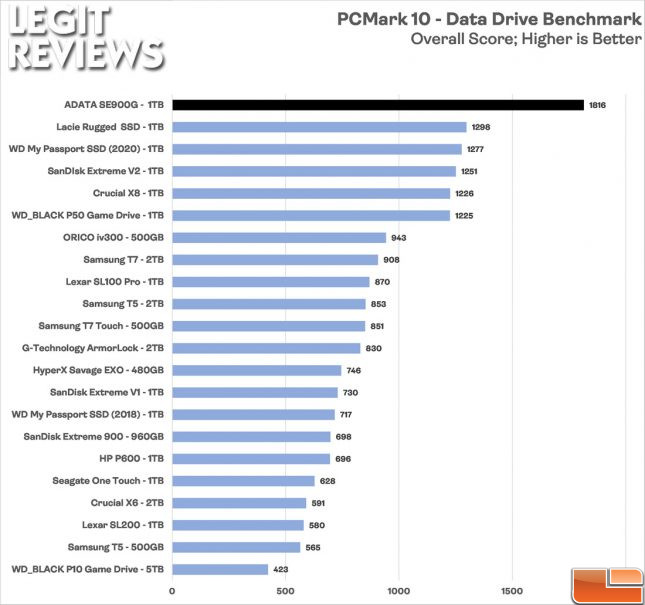ADATA SE900G 1TB RGB External SSD Review
PCMark 10 Data Drive Benchmark
PCMark 10
PCMark 8 was originally introduced in 2013 and the storage test uses only one thread to do everything. We are by no means living in the single-core era thanks to corporations like AMD offering CPUs with higher core counts than ever before. PCMark 10 Storage uses all the CPU cores available on the platform being tested and has been validated to support up to 5GB/s bandwidth. About half the available cores/threads are being used for generating the data needed for I/O and the other half are tasked with sending out I/Os. The I/O in both PCMark 8 and PCMark 10 is asynchronous. That means that the thread sending an I/O does not sit waiting for it to complete, but can instead queue more I/O to match the queue depth in the recorded trace. The CPU thread count used by the benchmark does not equal to the queue depth seen by the storage device. Most modern software has been written to be a muilthreaded solution where it can push IOs from multiple threads. This should play top the strengths of NVMe devices that have come out in recent years as they were designed to handle multiple queues at the same time. So, the take home message here is that PCMark 10 takes advantage of all available threads and uses newer real-world traces.
PCMark 10 – Data Drive Benchmark Results:
The Data Drive Benchmark is designed to test drives that are used for storing files rather than applications. You can also use this test with NAS drives, USB sticks, memory cards, and other external storage devices. The Data Drive Benchmark uses 3 traces, running 3 passes with each trace.
- Trace 1: Copying 339 JPEG files, 2.37 GB in total, in to the target drive (write test)
- Trace 2: Making a copy of the JPEG files (read-write test)
- Trace 3: Copying the JPEG files to another drive (read test)
On the PCMark 10 data drive benchmark the ADATA SE900G 1TB encrypted portable SSD finished with an overall score of 1816 points. That puts is miles ahead of the nearest competitor. We re-did this test many times as it was so much faster than any other USB drive.
The PCMark 10 Storage Benchmarks overall score is calculated from the bandwidth and average access time sub-scores. The bandwidth subtest is defined by UL in PCMark 10 as bandwidth = bytes / busy_time_for_read_and_write. The results here showed that the SE900G RGB External Drive averaged 280.2 MB/s during this trace test.
The final subtest result is the average access time. During a trace playback in PCMark 10, the start and end time is measured for each I/O. So, the average access time is derived from the end time of an I/O subtracted from the start time of that operation. An average access time of 89 microseconds was shown on the SE900G.




